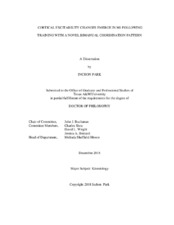| dc.description.abstract | Conceptually, motor skill memory has been divided into two distinct forms, which are explicit and implicit memory representations. These two memory components have distinct neural processing pathways. Extensive studies focusing on discrete and serial reaction time tasks (SRTT) have been done to explore these processing pathways to establish a link between memory consolidation processes and cortical excitability changes in motor cortex (M1) after training. Research has revealed distinct cortical excitability changes in M1 that differentiate a SRTT as either implicit or explicit. In the area of motor skill/learning, rhythmic bimanual coordination tasks are often treated as different from SRTT for a variety of reasons. The primary goal of this study was to determine if cortical excitability changes in M1 following training with a 90° bimanual coordination pattern would be more like changes observed after training with an SRTT in an implicit or explicit context. To accomplish the goal, transcranial magnetic stimulation (TMS) was used to probe M1 excitability before and after training. A secondary goal of this study was to examine whether or not training altered participants’ ability to perceptually discriminate aspects of the trained coordination pattern. A feature of explicit representation is the ability to recall the sequence after training, a feature not characteristic of an implicit representation. A recognition test introduced after a delayed-retention test of the trained 90° pattern was used to determine if training and delay interval interacted to establish changes in perceptual discrimination ability. The bimanual task required participants to produce the 90˚ relative phase pattern with finger abduction/adduction motions. Training
was facilitated by using a Lissajous plot to provide concurrent feedback. Before training and at 6 and 21 minutes after training motor evoked potentials (MEPs) were measured from the first dorsal interosseous (FDI) muscle. Participants had either a 30 minute or 6-hour delay after training before performing a set of retention test trials of the 90° bimanual pattern and then performing a recognition test of the finger motions used to produce the 90° pattern. At the end of training participants produced the 90˚ phase pattern with smaller error and variability compared to the beginning of training, and maintained the skill level gained at the end of practice until the delayed retention test. Cortical excitability increased above baseline at the 6 min and 21 min TMS probes after training, consistent with the pattern observed following training with an implicit SRTT. Participants were able to perceptually discriminate finger motions of the trained 90° pattern during the recognition test. The results suggest that participants’ developed an explicit representation of the bimanual 90˚ pattern. However, the ability to both produce and perceptually discriminate coordination patterns based on relative phase also suggest that relative phase as an order parameter links perception to action and thereby constrains and facilitates both action and perception processes in a similar manner. | en |


